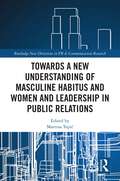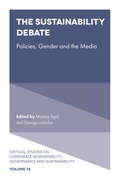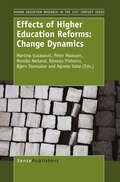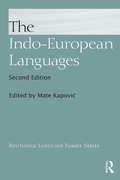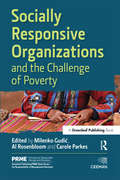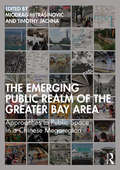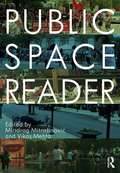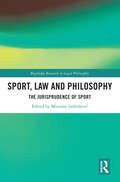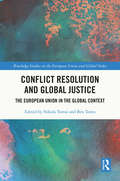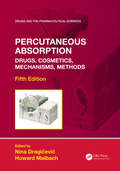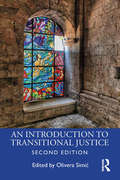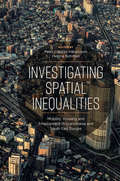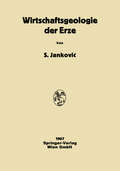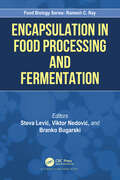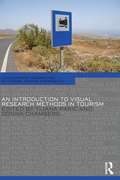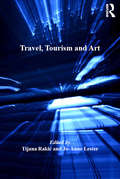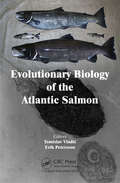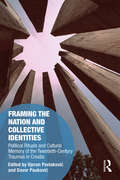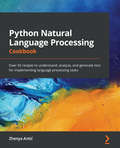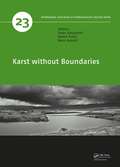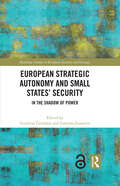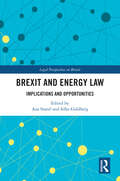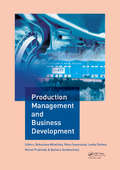- Table View
- List View
Towards a New Understanding of Masculine Habitus and Women and Leadership in Public Relations (Routledge New Directions in PR & Communication Research)
by Martina Topi 263This edited volume analyses leadership in the public relations (PR) industry with a specific focus on women and their leadership styles. It looks at how women lead, the inf luence of the socialisation process on leadership styles, the difference between feminine and masculine leadership styles, and the impact of leadership style on career opportunities for women. The book features case studies exploring leadership in PR around the world in an attempt to answer a central research question: is there a masculine habitus in the PR industry despite the rise of women in PR? The authors of each chapter conducted original research on women working in PR within their own country and provide original insights into the position of women in a feminised industry, as well as proposing new and original theoretical frameworks for future research. Written for scholars, researchers and students of PR and communication, this book will also be of interest to those studying gender studies, leadership and organisational analysis, and sociology.
The Sustainability Debate: Policies, Gender and the Media (Critical Studies on Corporate Responsibility, Governance and Sustainability #14)
by Martina Topi 263 George LodorfosThe Sustainability Debate is the result of a collaboration between academics and members of the Retail Institute predominantly working in retail and packaging industries. It responds to practitioners’ frustration with consumers’ emotionality and lack of knowledge around sustainability issues, problems often fostered by the media. This fourteenth volume of Critical Studies on Corporate Responsibility, Governance and Sustainability thus puts together a debate that goes beyond the rhetoric of environmental protection and looks at sustainability from several angles. The book is predominantly focused on human and social sustainability and this focus is carried into sections that discuss sustainable policies, media and gender. This volume ultimately moves away from merely discussing environmental protection and shifts to the effect sustainable policies have on people and society. With a scope expanded to include human and social sustainability as well as economic sustainability, this book’s original contribution is that is sees sustainability as a dynamic and complex system of human, social and environmental aspects.
Effects of Higher Education Reforms: Change Dynamics (Higher Education Research in the 21st Century #4)
by Martina Vukasovi 263 Peter Maassen Monika Nerland Rómulo Pinheiro Agnete VabøHigher education is in transition. On the one hand, over the last decades it has become politically and economically more important and thus also an object of reforms. On the other hand, higher education has become less special and is no longer able to justify its unique governance arrangements. This volume presents a collection of contributions that go beyond reform agendas as such and focus on the effects of reforms at all relevant levels in higher education systems. It is organised in four themes – education, research, governance, and academic profession – with a variety of levels of analysis, theoretical perspectives, methodological approaches and geographical foci. The topics in focus include the possible impact of latest national and European initiatives, changes in the primary processes (education and research) on the levels of institutions, professions and for individuals as well as higher education dynamics in contexts often overlooked in the literature (e.g. Africa). The aim is to ‘take stock’ of the growing knowledge basis with respect to higher education with a special focus on the influence of reforms on the key aspects of higher education.
The Indo-European Languages
by Mate Kapovi 263 Anna Giacalone Ramat Paolo RamatThe Indo-European Languages presents a comprehensive survey of the individual languages and language subgroups within this language family. With over four hundred languages and dialects and almost three billion native speakers, the Indo-European language family is the largest of the recognized language groups and includes most of the major current languages of Europe, the Iranian plateau and the Indian subcontinent. Written by an international team of experts, this comprehensive, single-volume tome presents in-depth discussions of the historical development and specialized linguistic features of the Indo-European languages. This unique resource remains the ideal reference for advanced undergraduate and postgraduate students of Indo-European linguistics and languages, but also for more experienced researchers looking for an up-to-date survey of separate Indo-European branches. It will be of interest to researchers and anyone with an interest in historical linguistics, linguistic anthropology and language development.
The Indo-European Languages
by Mate Kapovi 263 Anna Giacalone Ramat Paolo RamatThe Indo-European Languages presents a comprehensive survey of the individual languages and language subgroups within this language family. With over four hundred languages and dialects and almost three billion native speakers, the Indo-European language family is the largest of the recognized language groups and includes most of the major current languages of Europe, the Iranian plateau and the Indian subcontinent. Written by an international team of experts, this comprehensive, single-volume tome presents in-depth discussions of the historical development and specialized linguistic features of the Indo-European languages. This unique resource remains the ideal reference for advanced undergraduate and postgraduate students of Indo-European linguistics and languages, but also for more experienced researchers looking for an up-to-date survey of separate Indo-European branches. It will be of interest to researchers and anyone with an interest in historical linguistics, linguistic anthropology and language development.
Socially Responsive Organizations & the Challenge of Poverty (The Principles for Responsible Management Education Series)
by Milenko Gudi 263 Al Rosenbloom Carole ParkesThis book provides a combination of case studies and current action research describing how businesses and civil society organizations are working to alleviate poverty in local and global communities. It intends to provide conceptual and research rationales for why management education and management institutions must address the issue of poverty. The book responds to one of the major findings from the research of the PRME Working Group on Poverty that the topic of poverty still lacks a strong business case for management educators and program/institutional administrators. The distinctive features of this book are that it: (1) includes examples of small and medium-sized (SME) businesses; (2) deals with the issue of poverty as a human rights violation; (3) explores the issue of absolute versus relative poverty; (4) deals with leadership challenges in organizations committed to poverty alleviation; and (5) discusses the issues in terms of management education’s responsibility for setting new management, research institutional and intellectual agendas. The first of two books to be produced by the PRME Working Group on Poverty, Socially Responsive Organizations and The Challenge of Poverty aims to provide both researchers and practitioners with the most wide-ranging coverage yet published on how business can be a positive force in alleviating poverty and how management education needs to adapt to this increasingly crucial prerogative.
The Emerging Public Realm of the Greater Bay Area: Approaches to Public Space in a Chinese Megaregion
by Miodrag Mitrasinovi 263 Timothy JachnaThrough illustrated case studies and conceptual re-framings, this volume showcases ongoing transformations in public space, and its relationship to the public realm more broadly in the world’s most populous urban megaregion—the Greater Bay Area of southeastern China—projected to reach eighty million inhabitants by the year 2025. This book assembles diverse approaches to interrogating the forms of public space and the public realm that are emerging in the context of this region’s rapid urban development in the last forty years, bringing together authors from urbanism, architecture, planning, sociology, anthropology and politics to examine innovative ways of framing and conceptualizing public space in/of the Greater Bay Area. The blend of authors’ first-hand practical experiences has created a unique cross-disciplinary book that employs public space to frame issues of planning, political control, social inclusion, participation, learning/education and appropriation in the production of everyday urbanism. In the context of the Greater Bay Area, such spaces and practices also present opportunities for reconfiguring design-driven urban practice beyond traditional interventions manifested by the design of physical objects and public amenities to the design of new social protocols, processes, infrastructures and capabilities. This is a captivating new dimension of urbanism and critical urban practice and will be of interest to academics, students and practitioners interested in urbanization in China.
Public Space Reader
by Miodrag Mitrasinovi 263 Vikas MehtaRecent global appropriations of public spaces through urban activism, public uprising, and political protest have brought back democratic values, beliefs, and practices that have been historically associated with cities. Given the aggressive commodification of public re- sources, public space is critically important due to its capacity to enable forms of public dis- course and social practice which are fundamental for the well-being of democratic societies. Public Space Reader brings together public space scholarship by a cross-disciplinary group of academics and specialists whose essays consider fundamental questions: What is public space and how does it manifest larger cultural, social, and political processes? How are public spaces designed, socially and materially produced, and managed? How does this impact the nature and character of public experience? What roles does it play in the struggles for the just city, and the Right to The City? What critical participatory approaches can be employed to create inclusive public spaces that respond to the diverse needs, desires, and aspirations of individuals and communities alike? What are the critical global and comparative perspectives on public space that can enable further scholarly and professional work? And, what are the futures of public space in the face of global pandemics, such as COVID-19? The readers of this volume will be rewarded with an impressive array of perspectives that are bound to expand critical understanding of public space.
Sport, Law and Philosophy: The Jurisprudence of Sport (Routledge Research in Legal Philosophy)
by Miroslav Imbrisevi 263Sport, Law and Philosophy: The Jurisprudence of Sport discusses the intersection of law and sport and highlights its usefulness to both legal scholars and philosophers of sport. There is a general recognition that law and sports bear strong similarities. Both can be understood as systems of rules, with a judge/referee who has the power to adjudicate and to issue punishments/penalties. Divided into two parts, this volume presents an exploration of central philosophical issues arising from the intersections of law and sport and makes reference to current events and controversies. Experts from across the globe discuss a range of issues such as sports as legal systems, the game as a social contract, the role of the referee, including VAR, rule breaking, equality in women’s sport, justice on the sports field and in the court room, and issues surrounding the application of law to sports. The book will be a valuable resource to Undergraduates, Postgraduates and for those working in the areas of legal philosophy, sports law, and philosophy of sport.
Conflict Resolution and Global Justice: The European Union in the Global Context (Routledge Studies on the European Union and Global Order)
by Nikola Tomi 263 Ben TonraThis book examines how the different normative foundations of conflict resolution held by various global actors, their understandings of justice, and the differences between types of conflict influence the varying means by which conflicts can be prevented, managed, and ultimately resolved. By combining insights from political theory, conflict studies, and European Union (EU) foreign policy studies, the book identifies the EU as the key case of a conflict manager that is both a product and a defender of a global liberal order. It focuses on three aspects of conflict resolution that pose their own sets of both normative and empirical dilemmas: resolving border disputes; strengthening the resilience of weak or divided states and societies after regime change, and intervention in humanitarian crises. Furthermore, it offers a comparative analysis between a potentially distinctive European approach and that of other global actors and reflects critically on situations where policy practice may not always reflect a concern for justice, asking what countervailing forces prevail and why. This book will be of key interest to scholars and students in European and EU Studies, Area studies, Conflict Resolution, War Studies, EU Foreign Policy Political Theory, International relations as well as policymakers.
Percutaneous Absorption: Drugs, Cosmetics, Mechanisms, Methods (Drugs and the Pharmaceutical Sciences)
by Nina Dragi 263 Evi 263 Howard MaibachUpdating and expanding the scope of topics covered in the previous edition, Percutaneous Absorption: Drugs, Cosmetics, Mechanisms, Methods, Fifth Edition supplies new chapters on topics currently impacting the field including cutaneous metabolism, skin contamination, exposure to protein allergens, in vitro absorption methodology and the percutaneous absorption of chemical mixtures. Complete with studies on the role of the skin as a key portal of entry for chemicals into the body, this book serves as a detailed reference source for recent advances in the field, as well as an experimental guide for laboratory personnel. Key Features: Details in vivo and in vitro methods for measuring absorption, dermal decontamination, mechanisms of transdermal delivery, and the relationship of transepidermal water loss to percutaneous absorption Considers a range of mathematical models, the safety evaluation of cosmetic ingredients, the absorption of hair dyes, nanoparticles for drug delivery, and other novel methods of drug delivery Discusses topics including skin metabolism, the skin reservoir, and the effects of desquamation on absorption
An Introduction to Transitional Justice
by Olivera Simi 263The Second Edition of An Introduction to Transitional Justice provides a comprehensive overview of transitional justice judicial and non-judicial measures implemented by societies to redress legacies of massive human rights abuse. Written by some of the leading experts in the field, it takes a broad, interdisciplinary approach to the subject, addressing the dominant transitional justice mechanisms as well as key themes and challenges faced by scholars and practitioners. Using a wide historic and geographic range of case studies to illustrate key concepts and debates, and featuring discussion questions and suggestions for further reading, this is an essential introduction to the subject for students.
Investigating Spatial Inequalities: Mobility, Housing and Employment in Scandinavia and South-East Europe
by Peter Gladoi 263 Håkansson Helena BohmanSeen as one explanation for the election of Trump, Brexit and the surge of a right-wing movement across Europe, spatial inequality has become an increasingly relevant topic. Offering in-depth perspectives on factors such as local labour markets, housing and mobility, this book investigates centralization tendencies in Scandinavia and South East Europe that help shape regional development and act as a catalyst to creating regional inequalities. Joining scholars from four countries, this book provides a micro-examination of the development of regional inequalities in four geographically peripheral countries which represent different ends of the income spectrum, contain both EU and non-EU members and reflect differing levels of economic development. Divided into three sub-themes, the sections in turn discuss the topics of spatial divergence and labour market development, housing and institutional perspectives, and finally mobility, migration and commuting.
Encapsulation in Food Processing and Fermentation (Food Biology Series)
by Steva Levi 263 Viktor Nedovi 263 Branko BugarskiFood technology has adopted new principles and practices that are rapidly changing the food sector. New foods are now available under more uniform standards and better quality control. Globalised food market offers opportunities for manufacturers to increase production and profit, and at the same time, consumers benefit from the choice of food products like never before. All this is possible only because of the innovations in the food sector. One of such innovations is encapsulation technology, which aims to preserve food quality, enhance the sensorial properties of food and increase the efficiency in food processing. This book discusses the uses of encapsulation technology in food practices and conventional processes and also highlights new directions in food processing. In the introductory chapters’ review of encapsulation technologies, carrier materials and criteria for their selection, analytical methods for characterisation of encapsulated products and some aspects of product design and process optimisation. The most important achievements of encapsulation technology in the food sector are reviewed in the later chapters related to encapsulation of food ingredients, food biocatalysts and examples of usage of encapsulated active ingredients in the dairy and meat industry, beverage production, etc. In addition, the implementation of nanotechnology in the food sector is reviewed, emphasizing the most important materials and technologies for the production of nanoencapsulates. The book is a valuable source of information on encapsulation technology, for academia and industry, especially the food sector, with the aim of enhancing knowledge transfer.
An Introduction to Visual Research Methods in Tourism (Contemporary Geographies of Leisure, Tourism and Mobility)
by Tijana Raki 263 Donna ChambersAn Introduction to Visual Research Methods in Tourism is the first book to present, discuss and promote the use of a range of visual methods in tourism studies. It introduces methods ranging from the collection of secondary visual materials for the purposes of analysis (such as postcards, tourism brochures, and websites) and the creation of visuals in the context of primary research (such as photography, video and drawings), to the production of data through photo-elicitation techniques. The book promotes thoroughly underpinned interdisciplinary visual tourism research and includes an exploration of many key philosophical, methodological and inter-disciplinary approaches. Comprised of five parts: introduction; paradigms, academic disciplines and theory; methods; analysis and representation; and conclusion. This volume informs and inspires its readers through a reliance on theory, examples from tourism studies conducted in various geographical locations and through key pedagogical features such as annotated further readings, practical tips boxes and concise chapter summaries. This book will be of interest to experienced visual tourism researchers, scholars wishing to incorporate visual methods in their studies of tourism for the very first time, as well as students on undergraduate, postgraduate or doctoral programmes who are contemplating the incorporation of visual methods in their studies of tourism.
Travel, Tourism and Art (Current Developments in the Geographies of Leisure and Tourism)
by Tijana Raki 263 Jo-Anne LesterArt, in its many forms, has long played an important role in people’s imagination, experience and remembrance of places, cultures and travels as well as in their motivation to travel. Travel and tourism, on the other hand, have also inspired numerous artists and featured in many artworks. The fascinating relationships between travel, tourism and art encompass a wide range of phenomena from historical ’Grand Tours’ during which a number of travellers experienced or produced artwork, to present-day travel inspired by art, artworks produced by contemporary travellers or artworks produced by locals for tourist consumption. Focusing on the representations of ’touristic’ places, locals, travellers and tourists in artworks; the role of travel and tourism in inspiring artists; as well as the role of art and artwork in imagining, experiencing and remembering places and motivating travel and tourism; this edited volume provides a space for an exploration of both historical and contemporary relationships between travel, tourism and art. Bringing together scholars from a wide range of disciplines and fields of study including geography, anthropology, history, philosophy, and urban, cultural, tourism, art and leisure studies, this volume discusses a range of case studies across different art forms and locales.
Evolutionary Biology of the Atlantic Salmon
by Tomislav Vladi 263 Erik Petersson Francisco Ucan-MarinAtlantic salmon (Salmo salar, L) is an anadromous species contributing to major fishery catches and comprising a significant part of the aquaculturally produced fish for human consumption. The aim of this book is to incite the interest in the field of knowledge gathered from a broad scope of disciplines that have investigated this fish species. Und
Framing the Nation and Collective Identities: Political Rituals and Cultural Memory of the Twentieth-Century Traumas in Croatia (Memory Studies: Global Constellations)
by Vjeran Pavlakovi 263 Davor Paukovi 263This book analyzes top-down and bottom-up strategies of framing the nation and collective identities through commemorative practices relating to events from the Second World War and the 1990s "Homeland War" in Croatia. With attention to media representations of commemorative events and opinion poll data, it draws on interviews and participant observation at commemorative events to focus on the speeches of political elites, together with the speeches of opposition politicians and other social actors (such as the Catholic Church, anti-fascist organizations and war veterans’ and victims’ organizations) who challenge official narratives. Offering innovative approaches to researching and analyzing commemorative practices in post-conflict societies, this examination of a nation’s transition from a Yugoslav republic to an independent state – and now the newest member of the European Union – constitutes a unique case study for scholars of cultural memory and identity politics interested in the production and representation of national identities in official narratives.
Framing the Nation and Collective Identities: Political Rituals and Cultural Memory of the Twentieth-Century Traumas in Croatia (Memory Studies: Global Constellations)
by Vjeran Pavlakovi 263 Davor Paukovi 263This book analyzes top-down and bottom-up strategies of framing the nation and collective identities through commemorative practices relating to events from the Second World War and the 1990s "Homeland War" in Croatia. With attention to media representations of commemorative events and opinion poll data, it draws on interviews and participant observation at commemorative events to focus on the speeches of political elites, together with the speeches of opposition politicians and other social actors (such as the Catholic Church, anti-fascist organizations and war veterans’ and victims’ organizations) who challenge official narratives. Offering innovative approaches to researching and analyzing commemorative practices in post-conflict societies, this examination of a nation’s transition from a Yugoslav republic to an independent state – and now the newest member of the European Union – constitutes a unique case study for scholars of cultural memory and identity politics interested in the production and representation of national identities in official narratives.
Python Natural Language Processing Cookbook: Over 50 Recipes To Understand, Analyze, And Generate Text For Implementing Language Processing Tasks
by Zhenya Anti 263Over 50 recipes to understand, analyze, and generate text for implementing language processing tasks
Karst without Boundaries (Iah - Selected Papers On Hydrogeology Ser.)
by Zoran Stevanovi 263 Neven Kresi 263 Neno Kukuri 263Karstified rocks of different lithology cover more than 10% of the continental surface of our planet. It is known that some 20% or even a few percent more of the global population largely depends on karstic groundwater but in many karst areas all over the world there are limited natural resources including absence of drinking waters. The problems o
European Strategic Autonomy and Small States' Security: In the Shadow of Power (Routledge Studies in European Security and Strategy)
by Giedrius 268 Esnakas Justinas JuozaitisThis book analyses whether the EU’s drift towards European strategic autonomy presents a challenge or a window of opportunity for its small member states to advance their security interests. The volume presents small states’ perceptions of European strategic autonomy, highlighting their expectations and concerns. The chapters focus on the depth and breadth of European strategic autonomy, national security considerations, assessment of the impact on transatlantic relations, the expected outputs, and its potential impact on the EU’s institutional structure. It also shows how systemic circumstances and the interests of powerful states, either belonging to the EU (France, Germany, and Poland) or having a significant say in European security architecture (the US), establish opportunities and constraints for the small states to shape European strategic autonomy. In particular, the study focuses on the diverging interests of the Baltic states (Estonia, Latvia, and Lithuania), Belgium, Denmark, Greece, Hungary, and the Netherlands. It demonstrates that, in most cases, European strategic autonomy is perceived not as an alternative to NATO but as a supplementary element that could facilitate the development of national military capabilities, indigenous defence industries and resilience to non-military threats. Ultimately, the book suggests that national approaches towards European strategic autonomy mainly stem from pragmatic national security and foreign policy considerations, while largely ignoring grand strategic ideas. This book will be of much interest to students of European politics, security studies, and international relations.
Brexit and Energy Law: Implications and Opportunities (Legal Perspectives on Brexit)
by Ana Stani 269 Silke GoldbergBringing together leading experts from across the UK and Europe, this book provides a comprehensive analysis of the impact of Brexit on the energy sector in the UK and in the European Union and its Member States. In recent decades, the trend within the EU has been towards greater integration and liberalisation of energy markets. Through the development of the Union’s internal energy market and the funding of cross-border energy infrastructure, EU membership facilitates cross-border trade in energy, promotes security of energy supply, and, via the European Atomic Energy Community (Euratom), allows EU Member States to trade in nuclear material for energy production. Brexit changes all of this. The significant level of integration and interdependence in EU energy policy means that the UK’s departure from the Union poses many challenges for the UK, the EU, and EU Member States. While certain energy-related arrangements have been addressed, the relationship between the UK and EU in the energy sector has been changed fundamentally. In this context, important and interrelated questions arise, such as the following: Under what terms will energy trading between the EU and UK now take place? What access will the UK have to EU energy markets? What does Brexit mean for the security of energy supply? What does the UK’s departure from Euratom mean for nuclear research? Can the crossborder single energy market (SEM) on the island of Ireland continue following Brexit? What implications does Brexit have for renewables, the environment, and climate change? Brexit comes at a time when the European energy sector is undergoing the processes of decarbonisation and energy transition. This book offers researchers, legal practitioners, and policy advisers in-depth understanding of the interplay between these challenges and Brexit.
Production Management and Business Development: Proceedings of the 6th Annual International Scientific Conference on Marketing Management, Trade, Financial and Social Aspects of Business (MTS 2018), May 17-19, 2018, Košice, Slovak Republic and Uzhhorod, Ukraine
by Bohuslava Mihal 269 Ová Petra Szaryszová Lenka Stofová Michal Pru 382 Inský Barbora Gontkovi 269Trends in economic development rely on increasing human knowledge, which stimulate the development of new, sophisticated technologies. With their utilization production is raised and the intent is to decrease natural resources consumption and protect and save our life environment as much as we can. At the same time, increasing pressure is observed both from competition and customers. The way to be competitive is by improving manufacturing and services offered to the customer. These are the major challenges of contemporary enterprises. Organizations are improving their activities and management processes. This is necessary to manage the seemingly intensifying competitive markets successfully. Enterprises apply business-optimizing solutions to meet new challenges and conditions. This way ensuring effective development for long-term competitiveness in a global environment. This is necessary for the implementation of qualitative changes in the industrial policy. "Process Control and Production Management" (MTS 2018) is a collection of research papers from an international authorship. The authors present case studies and empirical research, which illustrates the progressive trends in business process management and the drive to increase enterprise sustainability development.
